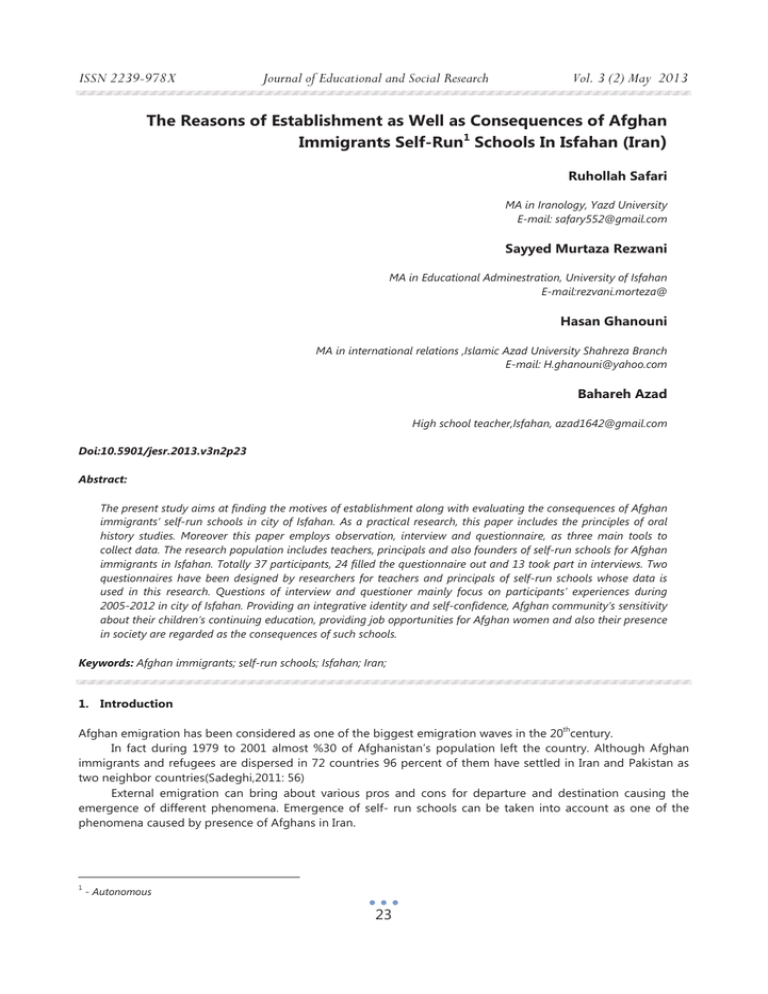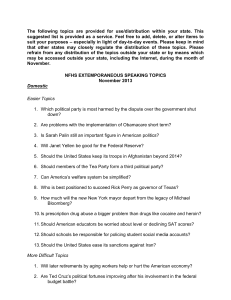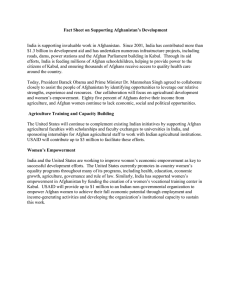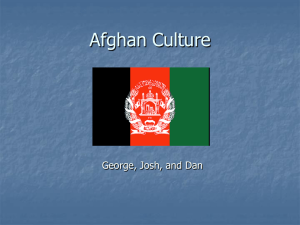Document 11945761
advertisement

ISSN 2239-978X Journal of Educational and Social Research Vol. 3 (2) May 2013 The Reasons of Establishment as Well as Consequences of Afghan Immigrants Self-Run1 Schools In Isfahan (Iran) Ruhollah Safari MA in Iranology, Yazd University E-mail: safary552@gmail.com Sayyed Murtaza Rezwani MA in Educational Adminestration, University of Isfahan E-mail:rezvani.morteza@ Hasan Ghanouni MA in international relations ,Islamic Azad University Shahreza Branch E-mail: H.ghanouni@yahoo.com Bahareh Azad High school teacher,Isfahan, azad1642@gmail.com Doi:10.5901/jesr.2013.v3n2p23 Abstract: The present study aims at finding the motives of establishment along with evaluating the consequences of Afghan immigrants’ self-run schools in city of Isfahan. As a practical research, this paper includes the principles of oral history studies. Moreover this paper employs observation, interview and questionnaire, as three main tools to collect data. The research population includes teachers, principals and also founders of self-run schools for Afghan immigrants in Isfahan. Totally 37 participants, 24 filled the questionnaire out and 13 took part in interviews. Two questionnaires have been designed by researchers for teachers and principals of self-run schools whose data is used in this research. Questions of interview and questioner mainly focus on participants’ experiences during 2005-2012 in city of Isfahan. Providing an integrative identity and self-confidence, Afghan community’s sensitivity about their children’s continuing education, providing job opportunities for Afghan women and also their presence in society are regarded as the consequences of such schools. Keywords: Afghan immigrants; self-run schools; Isfahan; Iran; 1. Introduction th Afghan emigration has been considered as one of the biggest emigration waves in the 20 century. In fact during 1979 to 2001 almost %30 of Afghanistan’s population left the country. Although Afghan immigrants and refugees are dispersed in 72 countries 96 percent of them have settled in Iran and Pakistan as two neighbor countries(Sadeghi,2011: 56) External emigration can bring about various pros and cons for departure and destination causing the emergence of different phenomena. Emergence of self- run schools can be taken into account as one of the phenomena caused by presence of Afghans in Iran. 1 - Autonomous 23 ISSN 2239-978X Journal of Educational and Social Research Vol. 3 (2) May 2013 By “self –run school” ,we mean the schools, established and run by immigrants that educate and train the children and teenagers .while most immigrant’s children can study in Iran’s school, the illegal ones cannot and have to enter these schools. According to rules of Iran, these schools are prohibited; in fact, they work privately, without ministry of education’s supervision and with receiving the fees from students in different cities of Iran. 2. Methodology As a historical research, the present study uses oral history as a research method to respond research questions. Adopting the approach of oral history, researchers have tried to record one part of Afghan immigrant’s social life in Isfahan. Secondary analysis and survey research have been employed to show the framework of the study.in secondary analysis or secondary data analysis, researcher investigate and analyzed the dimensions and goals of the research. In the survey research phase, they designed a questionnaire and interview to collect, arrange and categorize the data. In 2011, during the first phase, the number and location of self-run schools in Isfahan were recognized based on the received information from the office the theology ministry in Afghanistan embassy. Next 15 schools in Isfahan were selected randomly, meanwhile 24 teachers’ principals were chosen by considering their race, religion and length of their settlement in Iran to fill the questionnaires out. 2researcher-made questionnaires have been designed while were completed by 24researchers and principals. Along with the data found cut of questionnaires in spring of 2012, 7 teacher as well as 4 principals and founders of self-run schools in Isfahan were identified, next in the following month; they took part in a deep detailed interview. Among them 8 were men and 3 were women. 9 participants were shite and 2 were Sunni. Also, about race, 1was Pashtoon, 2 were Tajik, 4Sayyedand 4 were Hazara. Moreover, the head of theology ministry of Afghanistan embassy and one principal of a non-profit elementary school were interviewed whose data is used in this article. 3. Afghan immigrants in Iran Iran has been recognized one of the main destinations for Afghan immigrants and refugees seasonal th immigration of Afghan to Iran has been observed since the 19 century due to various economical differences. Additionally, shite Afghans have entered Iran make a pilgrimage throughout the history. The first recorded immigration of Afghan to Iran is traced back to 1941 when 5000 Hazara families emigrated and settled in Jam and Bakhraz(moosavi, 1997.148). Furthermore during 1880 to 1908 in government of Amir Abdolrahaman, Afghan families, inhabited in the city of Torbat-jam in the province of Khorasan that formed 90 percent of the th local population. Also, commuting to Iran, especially in late 19 century, many hazara families settled in various cities of Khorasan as well the villages in the vicinity of borders, along with Jam river from Hari-rood branches who are known as (Barbari) or (Khavari)ethnic group (Abbasi Showazi et. al,2005:43). The censusof 1990 indicates that foreign national formed nearly two percent of Iran’s population who has inhabited in various areas. According to the results of this census, although the population of Afghans was estimated about 1.4 million, it could be up to 2.15 million due to 1 or 1.5 million illegal immigrants. Provincial distribution of Afghans in Iran suggests that, Isfahan after Tehran and Khorasan has the highest population of Afghans (the statistical center of Iran, 2011). Expert of nationals and immigrants department of Isfahan governor-generalship office claims that illegal immigrants can be up to more than 300 thousand. Among them, about 140 thousand, have ID cards, whereas nd more than 180 thousand don’t who are living illegally in Isfahan (2 participant, 2012).These immigrants’ children, even the illegals, play a crucial role in emergence of a phenomenon called “self-run school”. there is no precise statistics about the number of Afghan students but Gholam Hazrat Tanha, the head of education department of Afghanistan embassy in Tehran believes that “the total number of immigrant students(either legal or illegal)is nearly 400 thousand in 2012. Among them260 thousand are studying in governmental and nonst profit schools all over Iran’’ (1 participant, 2012). Among 182 active self-run schools, 34 are high schools, 148 are 24 ISSN 2239-978X Journal of Educational and Social Research Vol. 3 (2) May 2013 junior high and elementary schools. According to statistics of Afghanistan embassy in Tehran, totally 1316 teachers are teaching in self-run schools, 913 women, 405 men (ibid,2012).Researches of the researchers showed that currently 7 self-run schools are working in Isfahan which is the educational centers for nearly 3000students who are mainly illegal immigrant’s children, But it is worth noting that the number of self-run schools in Isfahan had reached up to30 in 84-85 that most of them were sealed because of strict rules of interior ministry and also th the laws that made them stop their activity (14 participant 2012). Isfahan is one of the cities, accepting many Afghan immigrants during last 3 decades. Accordingly, the self-run schools are not very unusual and many self-run schools have been active in this city. 4. Findings By 60s AH and start civil wars in Afghanistan along with the emergence of the Taliban, emigration to Iran was intensified. On the other hand, Iran was not willing to admit the immigrants legally, causing them to enter and settle in illegally. In such a situation, immigrants’ children were not able to educate in governmental schools due to having no residence card that made them have no undecided future. First, their families accused the parties (moosavi, 2012:125). These parties have been allowed to work in Iran, because of the special situation, caused by the presence of the Soviet Union forces in Afghanistan. th The 9 participant who had been one of the activists of Sazman-e-Nasr-one of active Shiite parties of 60shas put that: “after establishment of parties’ offices in Tehran, and consequently in cities such as Isfahanand Mashhad some educational classes as well as other courses like Art, Quran, etc. were held as the response to Afghans families' requests. In fact ,not only Shiite parties including Nasr, Islamic movement ,Nehzate-eslmi , Pasdaran-e-jahad, etc., but also Sunni parties, active in Iran like the Hezb-e-eslami dependent on Hekmatyar, Jameiyat-e-eslami, led by Rabbani, and Mahaz-e-melli etc. were active and founded educational institutions '' th (9 participant, 2012). During these years and before the limitation of Shiite parties in the form of'' Hezb-e2 wahdat-e- eslami '', some classes were held illegally and also kids and teenagers had been taught in Quran classes as well as literacy campaigns. After ceasing the operations of Afghan parties and announcing their activities as illegal ones, immigrants hoped to go on with the help of elders and clergy men. Being respected by many people in Afghanistan and Iran, these clergy men could establish the schools which were named “self-run schools”. That explains why Afghan clergy men had been heads, founders and even the board of trustees, but of course before recent years when these schools were announced to be illegal. Although no specific evidence is found supporting the exact reason of emergence of self-run schools, there are some clues signifying this point that this phenomenon gets back to 60s. Mohammad Karim Moradi, the manager of Amir Almomen in cultural complex and the head of supervision council of Afghan self-run schools in Tehran in 2003, told Soore Journal: “Self-run schools started their activity about 16 years ago (i.e. in 1987) by opening some small schools in Mashhad. First due to this fact that the immigrant population was more, ministry of education n Mashhad design a pedagogical system in which Afghan students had to educate separately. In Tehran most Afghan had a valid ID card, however, it was noticed that the number of Afghan students with no ID card who can’t educate had been increasing… these students have been gathered spontaneously in small leased houses to educate” (Saadati, 2003:14). There are several reasons and bases to support the phenomenon of “selfrun schools” which are categorized as follow: - The reluctance of some immigrants, especially SunniPashtun to let their children educate in Iran's governmental schools: Due to the fear of Shiite thinking into their children's minds, this group taught the children at home, taught Quran to them, or used their own religious books instead of the ones taught in Iran (Barikani, 2012: 24). Some th Afghans especially Sunnis were so bias that didn’t allow their daughters to study. The 13 participant who is the principal of one self-run school states: “some parents don’t let their daughters continue their education after the 2 “Hezb-e- wahdat-e- eslami” which means “Islamic Solidarity Party” is one of the Shiite political parties in Afghanistan that includes 8 parties in 1989, being made in Iran, these parties got united within one. Abdul Ali Mazari was the leader of the party who as killed by the Taliban (Wikipedia, 2012). 25 ISSN 2239-978X Journal of Educational and Social Research Vol. 3 (2) May 2013 elementary level. We have negotiated with their families to let their children study at schools, but they don’t even allow their daughters to leave the hose. Some parents, especially Sunnis, are afraid of their children’s th perversion out of home and prefer to teach them at home instead” (13 participant, 2012). - The situation and job status of immigrant families along with their distance from governmental schools: Some immigrants have settled in slums and suburbs such as brick- burners and poultry farms.Although being qualified to enter governmental school, these children are deprived of studying in these schools due to long distance from main parts of the big cities. - Lack of age and education agreement to the needed ones in Iran's governmental schools: A number of Afghan children and teenagers were not qualified to enter Iran’s governmental schools, because of their age. They usually were older than the students whowere educating in elementary level, therefore were not able to enter schools. Moreover, there were some students who had studied in Afghanistan and were eager to be admitted in higher levels. But they could not pass the entrance exam and also their certificate was not th confirmed by Iran's ministry of education. As a result, they had no options but self-run schools. The 18 participants told the researcher about the supporting reason of self-run schools establishment: ''many immigrant students who had just left Afghanistan did not what to do, because their age was higher than the certain range of elementary schools. Some parents came to our house where Quran class was held in to ask us making a school for their children. With the help of one clergy man, we took a place near house and started the th school with two classrooms '' (18 participant, 2012). - Having financial problems to pay educational fees of governmental schools: According to pay a certain tuition since 1382, which was separate from the money paid to school as a help. The th 11 participant whose 9-year-old child studies in a secondary school in Isfahan puts:'' this year (2011-2012),the 3 rd school asked us to pay 70000 Toman for my son in 3 grade of secondary school, and 90000 Toman of each of my daughters in secondary school, as well. This money is separate from the one all families have to pay as the help to school. This year, Ihave paid about 400000 Toman to school which is really high for me due to other high th prices of other need''(11 participant, 2012). The high prices of immigrant's lives are one of the reasons that not only makes some children stop studying, but also results in developing numbers of self-run schools as the consequence of its low fees and no need to the residence card. - No educational permission to the students without certificate: Although having the valid residence card, these students are not able to educate, because they don’t have their last degree with them. Hence, many students whose degrees were not confirmed by education ministry, decided to choose self-run schools. Since 2010, while self-run schools’ activities had been announced illegally, according to the president, even the students without the residence card could go on their education in case they showed the governor’ letter. Mohammad Ali Yazdikhah (2011), the head of Tehran’s education department stated: “We don’t have any illegal foreign student in our system and all can be registered with governors’ license. Sometimes, issuing the license is postponed, but all the schools are asked to register foreign national students, due to cultural and social consideration. Also, it is emphasized that those whose residential documents have problem, have 2 or 3 months to present their complementary documents” (Fars news agency, 2011). - 3 Subjective reactions toward immigrants’ registration: - Iran Currency 26 ISSN 2239-978X Journal of Educational and Social Research Vol. 3 (2) May 2013 In spite of the fact there is no legal obstruction for registering immigrant children in governmental schools of Isfahan, in some cases, subjective and different reactions of principals of governmental as well as non-profit schools have made these students return to self-run schools that brings about their development. The 7th participant told the researcher about the experience of hos child’s registration on one of non-profit schools of Isfahan: “I went to register my child in first grade of school in a non-profit one on Parvin Street. The principal told me that all the rules had changed and they had to register electronically by using ID Number, therefore, th having no ID number, immigrants could not register'' (7 participant, 2012). The researcher went to one of these non-profit schools in Isfahan and asked the reason of not registering th the 7 participant's child. The principal claims: the laws regarding Afghan's enrollment fluctuate every year; one year, we are supposed to accept them, next year note. Anyway, we are willing and free not to enroll them because if some Iranian families who pay tuitions for their children, find out their children's classmate is an Afghan, we will be in a trouble; consequently our registration rate will decrease .thus we would rather not enroll them and give them a referral to governmental schools. In fact, when I was a principal in a governmental school, th Ihad no problem with this matter and registered them, if ministry of education asked'' (10 participant, 2012Khordad). 5. Iran's policy about self-run schools Taking a historical view toward Iran's policies about the community of Afghan immigrants during last 3 decades into account, we will come to this point that Iran's behavior to Afghans have been derivate from 2 main factors; first political change in Afghanistan, and second political and social changes in Iran. In 60s, we observed Iran's attention to immigrants due to political affairs in Iran as well as changes in former Soviet; in fact, Afghans were treated as Iranian citizens. Then some Afghans, like Iranians, took part in the war between Iran and Iraq and even were killed. However, when Russian forces left Afghanistan in 1989, and the war between Iran and Iraq finished, limitations and pressures on Afghan Immigrants were intensified. This is the time signifying the illegal entrance of many immigrants and refreshing self-run schools (Moosavi, 2012:135). Islamic republic of Iran has had different reactions toward self-run schools during various times. First, the emergence of these schools caused no negative reaction and therefore they were not illegal. In some cases, even education departments had positive th cooperation with this school. As the 14 participant states: ''In some areas, even education departments let us use one shift of governmental schools as well as their new desks for free. Of course, this case refers to the time th when the activity these schools were not illegal’’ (14 participant, 2012). Meanwhile, the number of immigrant students was increasing, especially by 1997 when the Taliban was powerful. After the Taliban's failure and forming transitional government in in Afghanistan, Iran decided to limit self-run schools, because it was believed that training institutes and vocational schools as a privilege demotivates immigrants to came back although educational centers were supposed to perform the law, local nationals office and the polices' reactions were subjective an even with indulgence. But after 2011, government th announced that this form of education was totally forbidden and reactions were so stricter. As the 17 participant who has been one of the founders of these schools in Isfahan points out: '' Despite the fact that our activities were prohibited, few schools were closed, expect when there was a private plaintiff such as neighbors that made us move the location, even if the police objected to our activity. The problem would be solving very th easily by reference to a well-known clergy men and Imam Jomethat let us continue our activities''(17 participant, 2012).Next, by 2005, all national offices of different cities, the police, education ministry and also other training institutes received a bylaw, making them take the actions against these schools and therefore, Many of them were sealed. As Moosavi, the chief of foreign nationals and immigrants department of Tehran states: '' In fact, self-run school for illegal Afghan validates their presence. That is why their activity is prohibited even if Iranianis collaborating (Armannewspaper, 2010: 15). Repeating this point that self-run schools are not legal and in case of recognition, they will be punished, he adds: '' according to our agreement with ministry of the interior, literacy campaigns and active NGOs 1 it is supposed to provide education and social skill training field for legal Afghan children whenever these campaigns and NGOs have enough space'' (ibid, 2010). Interviewing Etemad newspaper about the reasons of this strict reaction to self-run schools , Sayed Taghi Ghaemi, as the head of foreign nationals and immigrants department in ministry of the interior, claims :”these kids don’t receive the standard education; It has been observed that something. The lessons of the Taliban are 27 ISSN 2239-978X Journal of Educational and Social Research Vol. 3 (2) May 2013 taught to them making the prepared to join these forces when returning to Afghanistan“(Etemad newspaper, 2008:14). Also, he believed that the main reason to ban self-run schools is “to make a new appeal for new immigrants to Iran”: “If we let illegal immigrants educate , anew and great ware including Afghan refugees will leave their country to come here, due to this fact that they think our policies toward illegal immigration has been changed to kind ones. Indeed, it is against .we strictly are against to the entrance of illegal immigrants and try to encourage legal ones to come back “(ibid, 2008). In spite of all these strict rules, there have been some schools in suburb of Isfahan. Continuing their activity; there have been some schools in suburb of Isfahan. Continuing their activity; there are 7 active schools according to the head of theology department of Afghanistan embassy. However, they are working very secretly and limitedly. Researchers have visited 4schools in Khomeyni-shahr, Dolat Abad, and Zeynabiyeh during last year and have interviewed their teachers and founders. Considering this fluctuation in Iran’s policy about Afghan immigrants and their kids, Dr.Seyed Jafar Ahmadi, one of the principals of self-run schools in Isfahan who has experience running one school in Qom as well, puts: “In any case, Iran and every host country can have different rules and reason for immigrants and their kid’s education. Nowadays, self-run schools are considered as an undeniable social phenomenon that needs more attention. Exactly this requirement justifies the role of an agent who has been supposed to organize these schools in Afghanistan embassy since 2003. It is worth noting that self-run schools have had a crucial role in educating the children without learning opportunity.”(3rd participant, Khordad 2012). 6. The consequences of self-run schools The presence of Afghanistan women in society is believed as one of fundamental consequences of self-run schools during last decade. Afghanistan’s traditional patriarchal society has hardly ever let women have free social activities. But the presence of Afghanistan in Iran for several years and therefore being effected by Iran’s society as well as selecting Iran’s educational system as a model especially in elementary schools where women do the main part of education have cause many educated Afghan girls and women to enter the field of education and consequently, almost many teacher in these schools are women. Most of these women believe that their families wouldn’t let them work, if they wanted to work somewhere except these self-run schools. Furthermore, since many founders of these schools were among women, they decided to invite ladies to work with them. It needs to be mentioned that because of the low paid salary, men as the breadwinners would prefer not to enter this field. And as the result women have had more opportunities for that (Moosavi, 2012:138). One of the women who were the principal of one of the self-run schools tells: “the most important element in high selection of self-run schools by women is the low payment for teachers and therefore, men as the main part of providing families money are not willing to enter such fields. The second reason of women’s working at schools is the concordance of teaching to criteria of traditional society of Afghanistan. Women in th traditional families are hampered to choose many jobs but being a teacher matches with their beliefs” (30 participant, 2011). One of other women who teach in self-run schools believes that: “self-run schools have provided the field for Afghan ladies to improve their self-image and self-confidence, accept responsibilities and do it perfectly, highlighting the progress in social activities of Afghan ladies. The main role of such schools is that women come to this belief that they can be beneficial for other and take part in social events such as festivals, mourning th ceremonies etc. (5 participant, 2011). Sense of identity is another positive function, recorded for these schools in mosaic society of Afghanistan. In fact, due to limitations, imposed on these schools they have been recognized as centers for racial and religious convexity as well as familiarity of different people. Hence, identity back group of Iran along with racial indulgence found in executive and cultural body of these schools has had its unconscious effect; these schools have worked with a perspective beyond race and religion (Hoodfar, 2007:54). About understanding different races in these schools, one participant believes that: immigrant children from various areas, with various languages and dialects came there. Despite discrimination, observed these days even in Afghanistan, never did a teacher evaluate a student based on his/her language, race or religion. This is my honor that we had two teachers in our school that had different races and religious. A great solidarity had rd been manifested in self-run schools” (23 participant, 2011). 28 ISSN 2239-978X Journal of Educational and Social Research Vol. 3 (2) May 2013 7. Conclusion It seems that the children and teenagers education, especially the girls have become more important, despite Afghans past attitudes. Based of self-run schools activity, we have observed unification, self-confidence finding identity and also presence of Afghan ladies in society. Keeping the job limitations of Afghan immigrants in mind, it is possible to consider self-run school as one of the limited opportunities for Afghan girls to experience working out of home. Identity is one the positive functions of these schools in mosaic community of Afghanistan. In fact, self-run schools have played the role of a center of racial and religious convexity as well as familiarity among Afghans. Thus, it is possible to come to this fact that identity ground of Iran along with observed racial indulgence in cultural and executive framework of these schools have had an unconscious impact and has made these schools work with an attitude beyond religious and racial differences. In other words, regarding this point that racial dissimilarities have been accepted in Iran, it is reasonable to state that taking part in such schools makes people ready to understand other races which is considered as one of the most crucial functions of these schools along with Afghanistan community. It can be predicated that if Afghan and Iranian policy makers invest commonly in this integrative identity, positive impacts on Afghanistan’s social and political development will occur and the problem of Afghan emigration will be removed during a long-term plan. The experience of self-run schools can be a useful and practical pattern for the government and educational system of both Iran and Afghanistan in all cases especially in time of emergency and unpredicted disasters. Other consequences of these schools during last two decades have been as follow: Although the phenomenon of self-run schools can have positive effect on Afghan settlement in Isfahan as well as other lacks and detects, it doesn’t seem that these schools are good options to impose pressure on parents to leave Iran. Also it is possible to conclude that international sensitivity about children’s rights and possible consequences of Afghan’s future generation’s attitude toward Iran, Iran national benefits will be influenced as well and no positive outcome will be observed for the two countries. On the other hand positive effects of these schools activities on immigrants shouldn’t be ignored. References: Abbasi-Shavazi,M.J, D.Giazebrook, H.Mahmmoudian, G.Jamshidiha, and R.Sadeghi, (2005). Return to Afghanistan? A study of Afghans living in Tehran, Kabul:Afghanistan and Research Evaluation Research. Arman newspaper (2010).Interview with director general of bureau for align and foreign immigrant affairs (BAFIA), cited at: www.armandaily.ir/index.php?option=com_conte Barikani, M. (2012).Little Afghanistan in the land of red ruby.Hamshahrinewspaper, Saturday, May 12, 2012, p. 24. Fars News Agency (2012). Interview with director general of education office of Tehran city. Cited at:http://www.farsnews.com/newstext.php?nn=9005081546 Hoodfar, H. (2007). Afghan immigrant youth try to refuse to be marginalized, Goftegoo, cited at:www.noormags.com Hosayni-Balkhabi, S. A. (2009). Advantages of Afghan Self-run schools in Iran. Cited at: http://husainy.blogfa.com/post/8. Iran Statistic Center (2011). Population and Housing Census 2011, immigrant section, cited at: www.sci.org.ir Moosawi (2012).The study of function of Afghan Self-run schools in Iran.M.A. thesis, faculty of Population, Tehran University. Mousavi,S.A.(1997). The Hazaras of Afghanistan An Historical,Cultural,Economic and Political Study,New York: St Martin’s press. Rahmati, Sh. (2008). Self-run schools are closed for Afghan Children. Etemad newspaper, Wednesday, November 5, 2008, p. 14. Saadati, A. (2003). Interview with chairman supervision council of Afghan Self-run schools in Iran, Soore, No. 4, pp. 4446. Cited at: http://www.noormags.com Sadeghi, R. (2011). Social-population adjustmentofsecond-generation of Afghanimmigrantsin Iran.PhD. Thesis, Tehran University. www.facebook.com/̶ϠϳλΣΗοϳόΑΗΎΑϫίέΎΑϣΗϳόϣΟ/1391. 29







